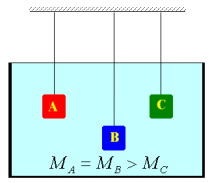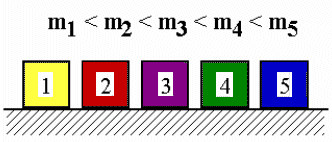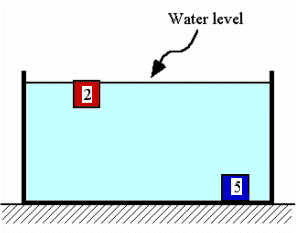| Homework due Nov. 17 | Name: | Section: |
Hanging Blocks
| Three cubical blocks of equal volume are suspended from strings. Blocks A and B have the same mass and block C has less mass. Each block is lowered into a fish tank and they hang at rest as shown in the figure at the right.
- Is the force exerted by the water on the top surface of cube A greater than, less than or equal to the force exerted by the water on the top surface of cube B? Explain..
- Is the force exerted by the water on the top surface
of cube A greater than, less than or equal to the force exerted by the water on the top surface of cube C? Explain.
- Is the force exerted on the water by block C greater than, less than or equal to the force exerted on the water by block A? Explain.
- Rank the buoyant forces acting on the three blocks from largest to smallest. If any buoyant forces are equal indicate that explicitly. Explain.
|
 |
Floating blocks
In the picture shown below are 5 blocks. The blocks have equal volumes but different masses. The blocks are placed in an aquarium tank filled with water and blocks 2 and 5 come to rest as shown in the lower figure. Sketch on the figure where you would expect the blocks 1, 3, and 4 to come to rest. (The differences in mass between successive blocks is significant — not just a tiny amount.)


<
The 3 vase puzzle*
Water is poured to the same level in each of the three vessels shown. Each vessel has the same base area. Since the water is to the same depth in each vessel, each will have the same pressure at the bottom. Since the area and pressure is the same, each liquid should exert the same force on the base of the vessel. Yet, if the vessels are weighed, three different values are obtained. (The one in the center clearly holds less liquid than the one at the left, so it must weigh less.) How can you justify this apparent contradiction?

* From A. Arons, A Guide to Introductory Physics Teaching (John Wiley & Sons, Inc. 1990).
Note to the instructor: This problem is too challenging for many introductory physics students. For it to be interesting, the puzzle solver must have reached a stage of development where they cross-link ideas and seek coherence. Many introductory students have not reached this point. It might keep your colleagues puzzled for a while, however!



